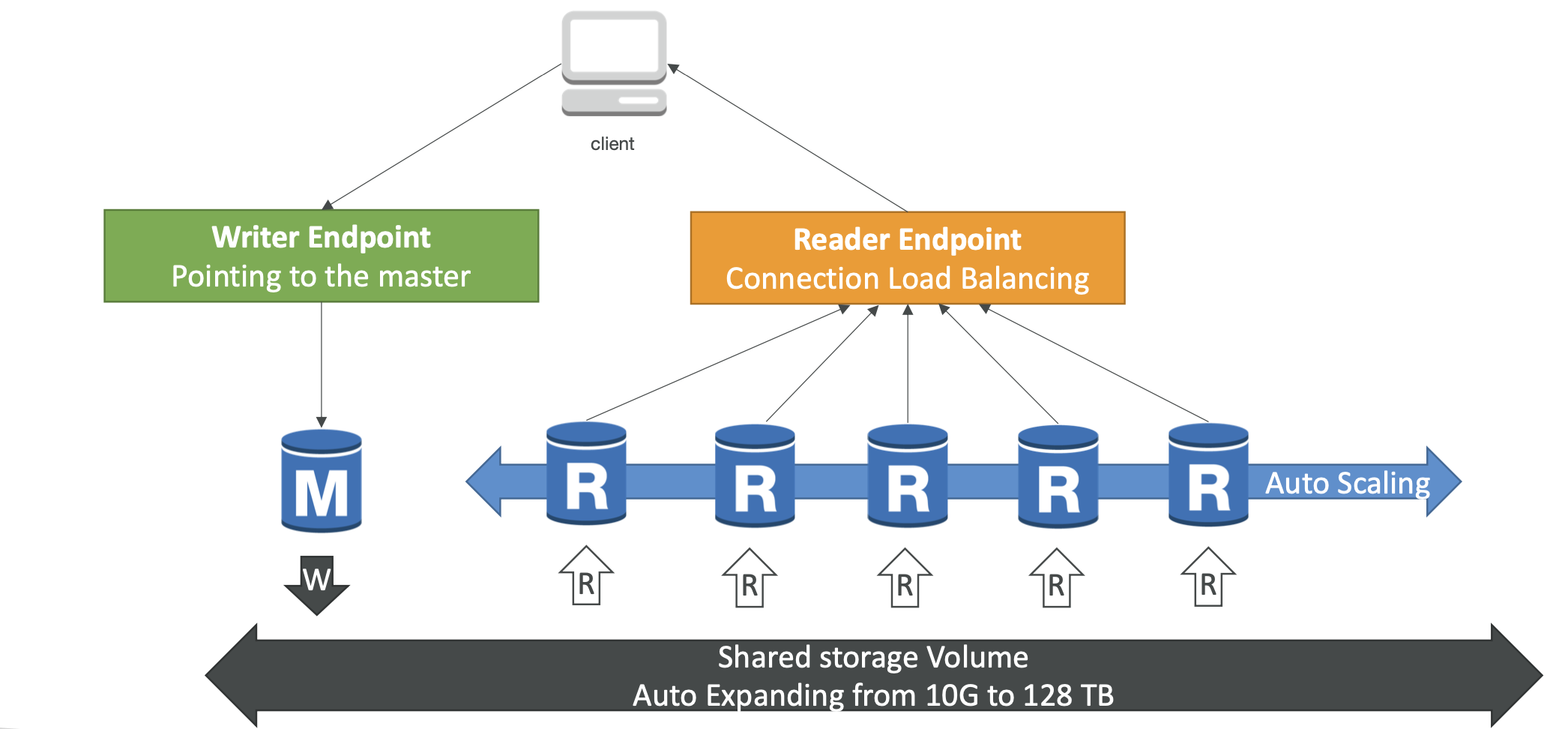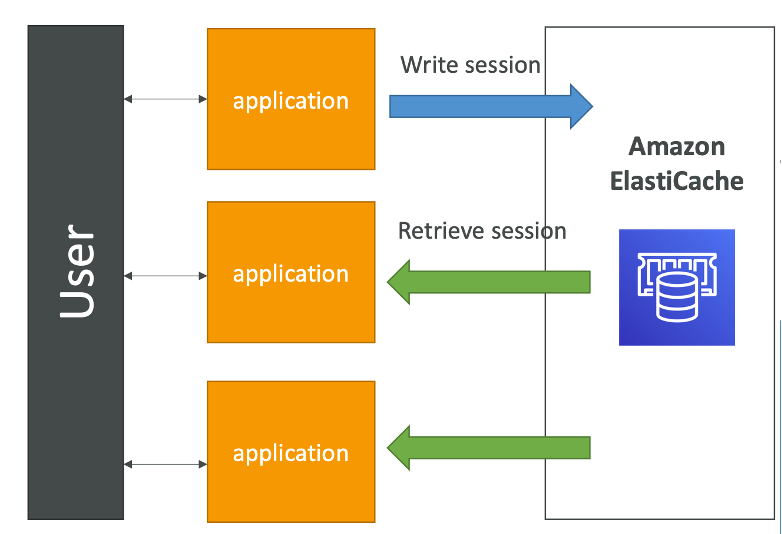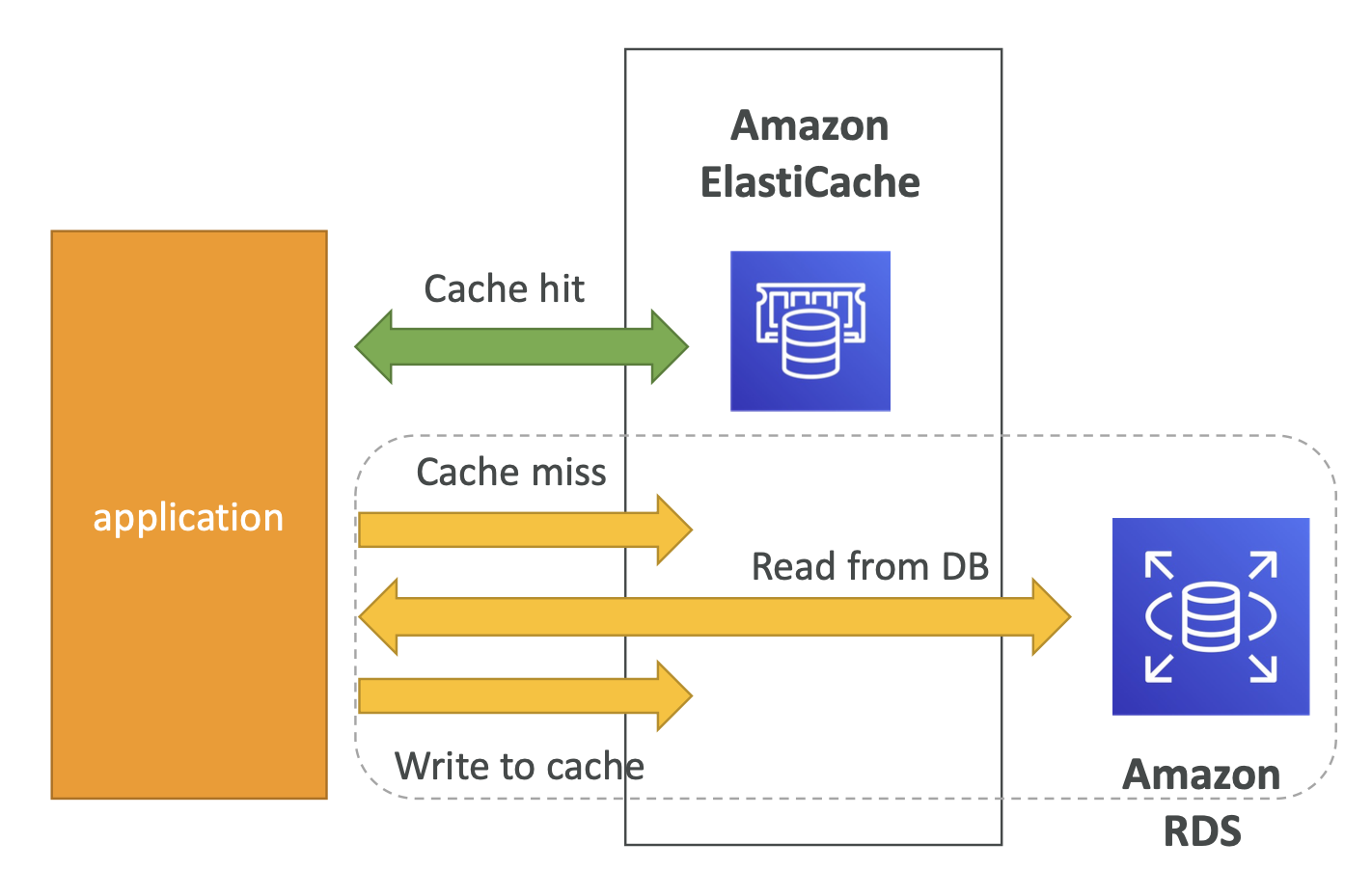RDS, Aurora & ElastiCache
If you are studying for AWS Developer Associate Exam, this guide will help you with quick revision before the exam. it can use as study notes for your preparation.
Dashboard Other Certification NotesRDS, Aurora & ElastiCache
- RDS, Aurora & ElastiCache
- RDS Overview
- RDS Custom
- Amazon Aurora
- RDS & Aurora Security
- Amazon ElastiCache Overview
- ElastiCache Solution Architecture - DB Cache
- ElastiCache Solution Architecture - User Session Store
- ElastiCache - Redis vs Memcached Replication
- ElastiCache - Cache Security
- ElastiCache Replication: Cluster Mode Disabled
- ElastiCache Replication: Cluster Mode Enabled
- Caching Implementation Considerations
- Lazy Loading / Cache-Aside / Lazy Population
- Write Through - Add or Update cache when database is updated
- Cache Evictions and Time-to-live (TTL)
- Which caching design pattern is the most appropriate?
- Amazon MemoryDB for Redis
RDS Overview
- RDS stands for Relational Database Service
- It’s a managed DB service for DB use SQL as a query language.
- It allows you to create databases in the cloud that are managed by AWS
- Postgres
- MySQL
- MariaDB
- Oracle
- Microsoft SQL Server
- Aurora (AWS Proprietary database)
Advantage over using RDS versus deploying DB on EC2
- RDS is a managed service:
- Automated provisioning, OS patching
- Continuous backups and restore to specific timestamp (Point in Time Restore)!
- Monitoring dashboards
- Read replicas for improved read performance
- Multi AZ setup for DR (Disaster Recovery)
- Maintenance windows for upgrades
- Scaling capability (vertical and horizontal)
- Storage backed by EBS (gp2 or io1)
- BUT you can’t SSH into your instances
RDS - Storage Auto Scaling
- Helps you increase storage on your RDS DB instance dynamically
- When RDS detects you are running out of free database storage, it scales automatically
- Avoid manually scaling your database storage
- You have to set Maximum Storage Threshold (maximum limit for DB storage)
- Automatically modify storage if:
- Free storage is less than 10% of allocated storage
- Low-storage lasts at least 5 minutes
- 6 hours have passed since last modification
- Useful for applications with unpredictable workloads
- Supports all RDS database engines (MariaDB, MySQL, PostgreSQL, SQL Server, Oracle)
RDS Read Replicas for read scalability
- Up to 5 Read Replicas
- Within AZ, Cross AZ or Cross Region
- Replication is ASYNC, so reads are eventually consistent
- Replicas can be promoted to their own DB
- Applications must update the connection string to leverage read replicas
Read Replicas - Use Cases
- You have a production database that is taking on normal load
- You want to run a reporting application to run some analytics
- You create a Read Replica to run the new workload there
- The production application is unaffected
- Read replicas are used for SELECT (=read) only kind of statements (not INSERT, UPDATE, DELETE)
Read Replicas - Network Cost
- In AWS there’s a network cost when data goes from one AZ to another
- For RDS Read Replicas within the same region, you don’t pay that fee
RDS Multi AZ (Disaster Recovery)
- SYNC replication
- One DNS name – automatic app failover to standby
- Increase availability
- Failover in case of loss of AZ, loss of network, instance or storage failure
- No manual intervention in apps
- Not used for scaling
- Multi-AZ replication is free
- Note:The Read Replicas be setup as Multi AZ for Disaster Recovery (DR)
RDS - From Single-AZ to Multi-AZ
- Zero downtime operation (no need to stop the DB)
- Just click on “modify” for the database
- The following happens internally:
- A snapshot is taken
- A new DB is restored from the snapshot in a new AZ
- Synchronization is established between the two databases
| Read Replicas | Multi-AZ |
|---|---|
| Scale the read workload of your DB | Failover in case of AZ outage (high availability) |
| Can create up to 5 Read Replicas | Data is only read/written to the main database |
| Data is only written to the main DB | Can only have 1 other AZ as failover |
-
Read Replicas

-
Multi-Region

RDS Custom
- Managed Oracle and Microsoft SQL Server Database with OS and database customization
- RDS: Automates setup, operation, and scaling of database in AWS
- Custom: access to the underlying database and OS so you can
- Configure settings
- Install patches
- Enable native features
- Access the underlying EC2 Instance using SSH or SSM Session Manager
- De-activate Automation Mode to perform your customization, better to take a DB snapshot before
- RDS vs. RDS Custom
- RDS: entire database and the OS to be managed by AWS
- RDS Custom: full admin access to the underlying OS and the database
Amazon Aurora
- Aurora is a proprietary technology from AWS (not open sourced)
- Postgres and MySQL are both supported as Aurora DB (that means your drivers will work as if Aurora was a Postgres or MySQL database)
- Aurora is “AWS cloud optimized” and claims 5x performance improvement over MySQL on RDS, over 3x the performance of Postgres on RDS
- Aurora storage automatically grows in increments of 10GB, up to 128 TB.
- Aurora can have 15 replicas while MySQL has 5, and the replication process is faster (sub 10 ms replica lag)
- Failover in Aurora is instantaneous. It’s HA (High Availability) native.
- Aurora costs more than RDS (20% more) – but is more efficient
Aurora High Availability and Read Scaling
- 6 copies of your data across 3 AZ:
- 4 copies out of 6 needed for writes
- 3 copies out of 6 need for reads
- Self healing with peer-to-peer replication
- Storage is striped across 100s of volumes
- One Aurora Instance takes writes (master)
- Automated failover for master in less than 30 seconds
- Master + up to 15 Aurora Read Replicas serve reads
- Support for Cross Region Replication

Aurora DB Cluster
- An Aurora DB cluster is a group of one or more Aurora instances that function as a single, highly-available database.
- The cluster is managed by Aurora and automatically handles tasks such as replication, backups, and failure detection.
- Aurora also provides a feature called Aurora Global Database, which allows you to create a single Aurora database that spans multiple AWS regions for even higher availability and disaster recovery.

Features of Aurora
- Automatic fail-over
- Backup and Recovery
- Isolation and security
- Industry compliance
- Push-button scaling
- Automated Patching with Zero Downtime
- Advanced Monitoring
- Routine Maintenance
- Backtrack: restore data at any point of time without using backups
RDS & Aurora Security
- At-rest encryption:
- Database master & replicas encryption using AWS KMS– must be defined as launch time
- If the master is not encrypted, the read replicas cannot be encrypted
- To encrypt an un-encrypted database, go through a DB snapshot & restore as encrypted
- In-flightencryption: TLS-readybydefault, use the AWS TLS root certificates client-side
- IAM Authentication: IAM roles to connect to your database (instead of username/pw)
- Security Groups: Control Network access to your RDS / Aurora DB
- No SSH available except on RDS Custom
- Audit Logs can be enabled and sent to CloudWatch Logs for longer retention
Amazon ElastiCache Overview
- The same way RDS is to get managed Relational Databases.
- ElastiCache is to get managed Redis or Memcached
- Caches are in-memory databases with really high performance, low latency
- Helps reduce load off of databases for read intensive workloads
- Helps make your application stateless
- AWS takes care of OS maintenance / patching, optimizations, setup, configuration, monitoring, failure recovery and backups
- Using ElastiCache involves heavy application code changes
ElastiCache Solution Architecture - DB Cache
- Applications queries ElastiCache, if not available, get from RDS and store in ElastiCache.
- Helps relieve load in RDS
- Cache must have an invalidation strategy to make sure only the most current data is used in there.

ElastiCache Solution Architecture - User Session Store
- User logs into any of the application
- The application writes the session data into ElastiCache
- The user hits another instance of our application
- The instance retrieves the data and the user is already logged in

ElastiCache - Redis vs Memcached Replication
| REDIS | MEMCACHED |
|---|---|
| Multi AZ with Auto-Failover | Multi-node for partitioning of data (sharding) |
| Read Replicas to scale reads and have high availability | No high availability (replication) |
| Data Durability using AOF persistence | Non persistent |
| Backup and restore features | No backup and restore |
| Multi-threaded architecture |
ElastiCache - Cache Security
- All caches in ElastiCache:
- Do not support IAM authentication
- IAM policies on ElastiCache are only used for AWS API-level security
- Redis AUTH
- You can set a “password/token” when you create a Redis cluster
- This is an extra level of security for your cache (on top of security groups)
- Support SSL in flight encryption
- Memcached
- Supports SASL-based authentication (advanced)
ElastiCache Replication: Cluster Mode Disabled
- One primary node, up to 5 replicas
- Asynchronous Replication
- The primary node is used for read/write
- The other nodes are read-only
- One shard, all nodes have all the data
- Guard against data loss if node failure
- Multi-AZ enabled by default for failover
- Helpful to scale read performance
ElastiCache Replication: Cluster Mode Enabled
- Data is partitioned across shards (helpful to scale writes)
- Each shard has a primary and up to 5 replica nodes (same concept as before)
- Multi-AZ capability
- Up to 500 nodes per cluster:
- 500 shards with single master
- 250 shards with 1 master and 1 replica
- 83 shards with one master and 5 replicas
Caching Implementation Considerations
- Read more at: https://aws.amazon.com/caching/implementation-considerations/
- Is it safe to cache data? Data may be out of date, eventually consistent
- Is caching effective for that data?
- Pattern: data changing slowly, few keys are frequently needed
- Anti patterns: data changing rapidly, all large key space frequently needed
- Is data structured well for caching?
- example: key value caching, or caching of aggregations results
- Which caching design pattern is the most appropriate?
Lazy Loading / Cache-Aside / Lazy Population
| Pros | Cons |
|---|---|
| Only requested data is cached (the cache isn’t filled up with unused data) | Cache miss penalty that results in 3 round trips, noticeable delay for that request |
| Node failures are not fatal (just increased latency to warm the cache) | Stale data: data can be updated in the database and outdated in the cache |

Write Through - Add or Update cache when database is updated
| Pros | Cons |
|---|---|
| Data in cache is never stale, reads are quick | Missing Data until it is added / updated in the DB. Mitigation is to implement Lazy Loading strategy as well |
| Write penalty vs Read penalty (each write requires 2 calls) | Cache churn – a lot of the data will never be read |

Cache Evictions and Time-to-live (TTL)
- Cache eviction can occur in three ways:
- You delete the item explicitly in the cache
- Item is evicted because the memory is full and it’s not recently used (LRU)
- Yousetanitemtime-to-live(orTTL)
- TTL are helpful for any kind of data:
- Leaderboards
- Comments
- Activity streams
- TTL can range from few seconds to hours or days
- If too many evictions happen due to memory, you should scale up or out
Which caching design pattern is the most appropriate?
- Lazy Loading / Cache aside is easy to implement and works for many situations as a foundation, especially on the read side
- Write-through is usually combined with Lazy Loading as targeted for the queries or workloads that benefit from this optimization
- Setting a TTL is usually not a bad idea, except when you’re using Write-through. Set it to a sensible value for your application
- Only cache the data that makes sense (user profiles, blogs, etc…)
Amazon MemoryDB for Redis
- Redis-compatible, durable, in-memory database service
- Ultra-fast performance with over 160 millions requests/second
- Durable in-memory data storage with Multi-AZ transactional log
- Scale seamlessly from 10s GBs to 100s TBs of storage
- Use cases: web and mobile apps, online gaming, media streaming